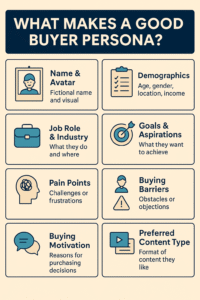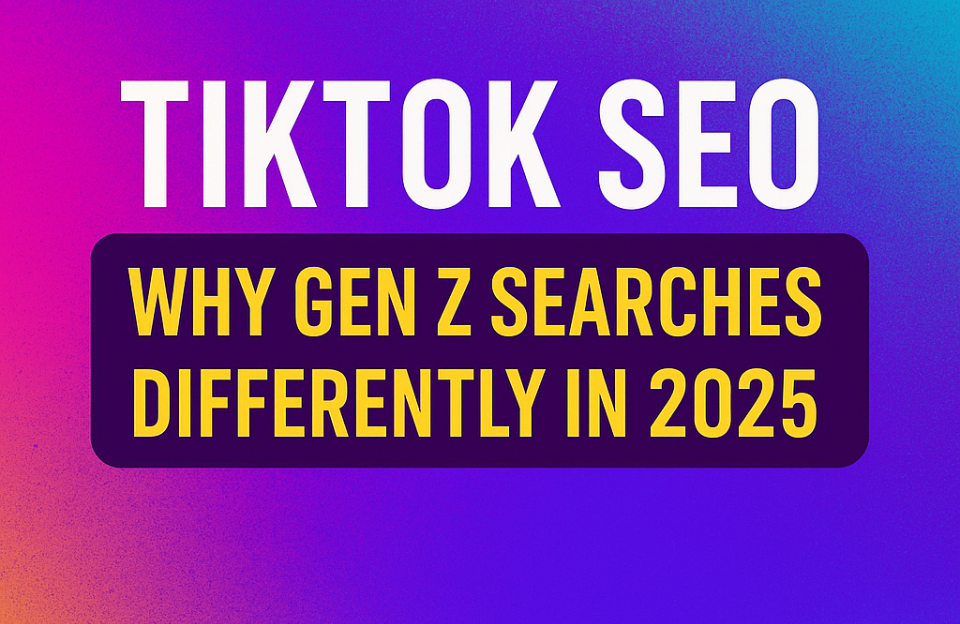What Is a Buyer Persona?
A buyer persona is a semi-fictional representation of your ideal customer based on data, research, and insights. It helps you understand your customers’ needs, behaviors, and motivations—so you can tailor your messaging, product offerings, and overall marketing strategy.
Personas go beyond basic demographics. They capture personal goals, frustrations, decision-making triggers, and even content preferences. In short: they humanize your audience and shift your focus from “who might buy” to “who are we really helping—and how?”
Why Buyer Personas Matter
- ✅ Create more relevant content and messaging
- ✅ Personalize marketing and sales approaches
- ✅ Improve customer acquisition and retention
- ✅ Align teams across marketing, sales, and product
- ✅ Prioritize features and campaigns that resonate
When done right, buyer personas become the common language across departments—clarifying who you’re building for, selling to, and talking with.
Types of Buyer Personas
Depending on your business model, you may need different types of personas. Here are a few common variations:
- Decision-maker: The person with final authority to approve purchases (e.g. a CEO, parent, or procurement officer)
- Influencer: Someone who impacts the buying decision (e.g. tech-savvy teenagers influencing family purchases)
- User persona: The person who actually uses the product, even if they don’t buy it directly (e.g. a child using a learning app bought by a teacher)
- Negative persona: A representation of people you do not want to target (e.g. bargain hunters for a premium brand)
Creating both positive and negative personas can save you budget and time by helping you avoid misaligned messaging or leads that won’t convert.
What Should a Buyer Persona Include?
- Name & Avatar: A fictional name and visual that bring the persona to life
- Demographics: Age, gender, location, income, education
- Job Role & Industry: What they do and where
- Goals & Aspirations: What they want to achieve
- Pain Points: Challenges that prevent progress
- Buying Motivation: What drives purchasing decisions
- Buying Barriers: What creates doubt or friction
- Channels: Where they get information (e.g. social media, blogs, Google)
- Preferred Content Type: e.g. video, case studies, reviews
How to Create a Buyer Persona
- 1. Analyze your existing customers
Use CRM data, interviews, surveys, support tickets, and sales insights to identify common traits, questions, and objections among your best customers. - 2. Identify key characteristics and segments
Cluster your customers not just by demographics, but also by needs, pain points, and motivations. For example, two 35-year-old women could have completely different buying behaviors based on lifestyle or career stage. - 3. Research your market and competitors
Scan online communities, social media comments, reviews, and public data to learn how your audience expresses itself—and what frustrates them. Tools like AnswerThePublic or SparkToro can help you dig deeper. - 4. Create 1–3 core personas
Avoid overcomplicating it. Start with a few realistic, high-impact personas that represent your best-fit customers. Give them names, backstories, and relatable details. - 5. Validate and refine regularly
Check with your sales and support teams: does this reflect the people they talk to daily? Use analytics and feedback loops to adjust personas as your market evolves.

Real-World Example 1: Apple – “Creative Millennial” Persona
Company: Apple
Persona: Emma, 28 – The Creative Millennial
- Demographics: Female, 28, lives in Amsterdam, freelance designer
- Goals: Produce high-quality digital content, stay ahead of trends
- Pain Points: Inconsistent performance with cheaper devices, time lost due to crashes
- Buying Motivation: Sleek, reliable tech that enhances creativity and status
- Buying Barriers: High price, doubts about switching ecosystems
- Preferred Channels: YouTube reviews, Instagram influencers, tech blogs
- Content Preference: Short demo videos, tutorials, aesthetic product visuals
How Apple uses this persona: Apple targets this persona in its MacBook and iPad Pro campaigns, focusing on performance, design, and emotional storytelling—often through creator testimonials.
Real-World Example 2: IKEA – “Young Urban Nesters” Persona
Company: IKEA
Persona: Alex, 31 – First-Time Apartment Owner
- Demographics: Male, 31, lives in Rotterdam, single, digital marketing professional
- Goals: Create a stylish, functional space on a limited budget
- Pain Points: Overwhelmed by interior design choices, lack of time
- Buying Motivation: Affordable, modular furniture that fits modern small spaces
- Buying Barriers: Assembly complexity, delivery waiting times
- Preferred Channels: Pinterest, Instagram, Google Search, IKEA catalog
- Content Preference: Step-by-step setup videos, AR room planners, budget guides
How IKEA uses this persona: IKEA’s room inspirations, planning tools, and product naming (e.g. “Kallax”) appeal directly to this persona’s practical and creative mindset.
Real-World Example 3: Nike – “Aspiring Everyday Athlete” Persona
Company: Nike
Persona: Priya, 35 – The Aspiring Everyday Athlete
- Demographics: Female, 35, lives in London, project manager, mother of two
- Goals: Stay active, manage stress, maintain health
- Pain Points: Limited time, inconsistent motivation, gym intimidation
- Buying Motivation: Comfortable, stylish, empowering activewear for real life
- Buying Barriers: Skepticism about performance claims, price vs value concerns
- Preferred Channels: Instagram, YouTube fitness influencers, fitness apps
- Content Preference: Inspirational reels, workout playlists, real customer stories
How Nike uses this persona: Nike’s “You Can’t Stop Us” campaign and Nike Training Club app content resonate strongly with this group, empowering everyday movement—not just elite athletes.
Conclusion
A strong buyer persona is not just a marketing document—it’s a decision-making tool. It helps shape product development, advertising, website content, social strategy, and even sales conversations.
When teams across departments align around a clearly defined persona, it leads to consistent communication and better customer experiences. Your ads speak their language. Your landing pages answer their questions. Your product roadmap supports their needs.
Don’t treat personas as a one-off branding exercise. Let them guide your choices daily—from campaign headlines to onboarding flows. The more you bring your persona to life across every touchpoint, the more magnetic your brand becomes to your ideal customer.




